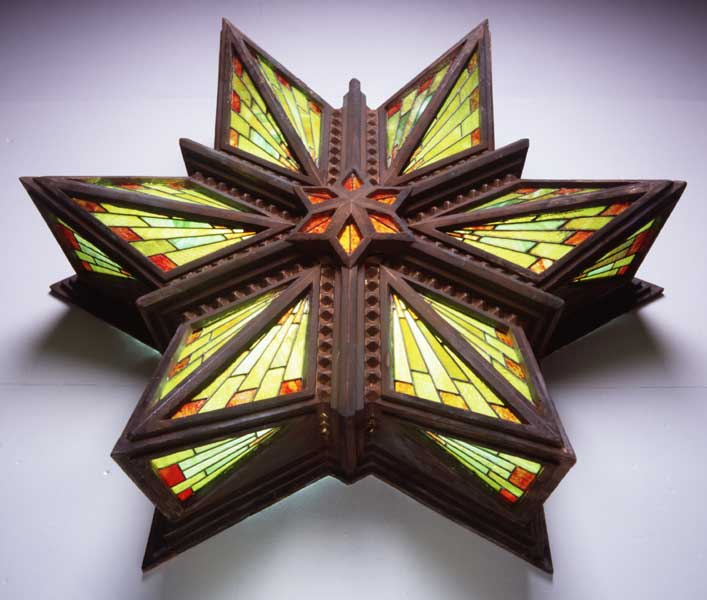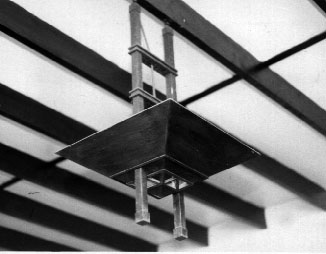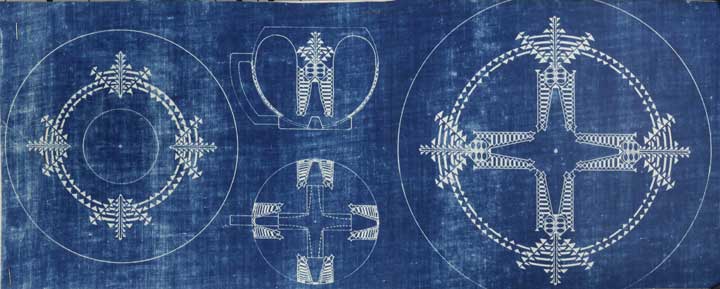Just as the Griffins stressed the necessity for creating architecture in sympathy with its landscape setting, so their designs for furniture and interiors expressed the aesthetic of their architecture. From their earliest projects in Chicago both Marion Mahony Griffin and Walter Burley Griffin designed interior schemes that reflected their integrated approach to architecture, an approach undoubtedly inspired by Frank Lloyd Wright’s unique interior design vocabulary as well as the then current Arts and Crafts movement. Marion Griffin’s interior design work in Wright’s office is now being increasingly recognised for its major contribution to Wright’s reputation, while the interiors and furniture completed for the houses she designed after Wright’s departure for Europe — such as the Irving and Mueller houses, Decatur, 1910 — were highly accomplished interpretations of the ‘Wright’ style.
But it was in Australia that the Griffins’ approach to interior design was given the opportunity to expand and mature. Their superb interior scheme for the Café Australia, Melbourne (1916 — now demolished) included decorative plasterwork, stained glass and tables and chairs with highly distinctive curved elements. For Newman College, Melbourne (1917) the Griffins again designed distinctive lighting, chairs and desks, this time in a functional, angular arts and crafts style. The stunning interiors for the Capitol Theatre, Melbourne (1924 — still partially intact) were the most flamboyant of the Griffins’ projects and included striking modernist carpets and stained glass lighting and windows, and an extraordinary prismatic plaster ceiling whose pulsating coloured light show still thrills visitors today.
From the mid 1920s the more modest interiors of the Castlecrag houses presented a different sort of challenge — the design of compact domestic spaces with multi-purpose and built-in fixtures and fittings. The Griffins’ pyramidal wooden ceiling light, used in a number of the Castlecrag houses, is one of the few identifiable individual designs from this period. Such was the importance to Walter and Marion of integrated interior schemes that they even designed their own furniture for their offices in Melbourne and Sydney.
Today the Griffins’ furniture and lighting are represented in the collections of the Powerhouse Museum and the Historic Houses Trust of NSW, Sydney, the National Gallery of Australia, Canberra, the National Gallery of Victoria, Melbourne and a number of private collections.
Ceiling light, Capitol Theatre, Melbourne, about 1924, coloured glass, wood, plaster, lead, 33x132x132cm. Powerhouse Museum collection 97/308/1. Photographer Penelope Clay. Courtesy Powerhouse Museum
Wooden hanging light at GSDA No.1 Dwelling, Castlecrag, Sydney 1992. Photo Walter Burley Griffin Society Inc. Collectio
Afternoon Tea Room and stairway to balcony of Banquet Hall at Café Australia, Melbourne, c. 1917. Photograph from Magic of America by Marion Mahony, Vol 3 page 67b. Collection of The New-York Historical Society 78495d
Café Australia “Dishes” on blue paper from Magic of America by Marion Mahony, Vol 3 page 92b. Collection of The New-York Historical Society 78485d
Author
Anne Watson is curator of architecture and design at the Powerhouse Museum and has an MA in Fine Arts from the University of Sydney. She has written and lectured widely on many aspects of nineteenth and twentieth century furniture history and design and has curated numerous exhibitions including ‘Beyond architecture: Marion Mahony and Walter Burley Griffin in America, Australia and India’. Anne is currently coordinating a book on the building of the Sydney Opera House.
Further reading
Watson. Anne (editor). Beyond architecture: Marion Mahony and Walter Burley Griffin in America, Australia and India. Powerhouse Publishing- Museum of Applied Arts and Sciences. 1998
www.powerhousemuseum.com




